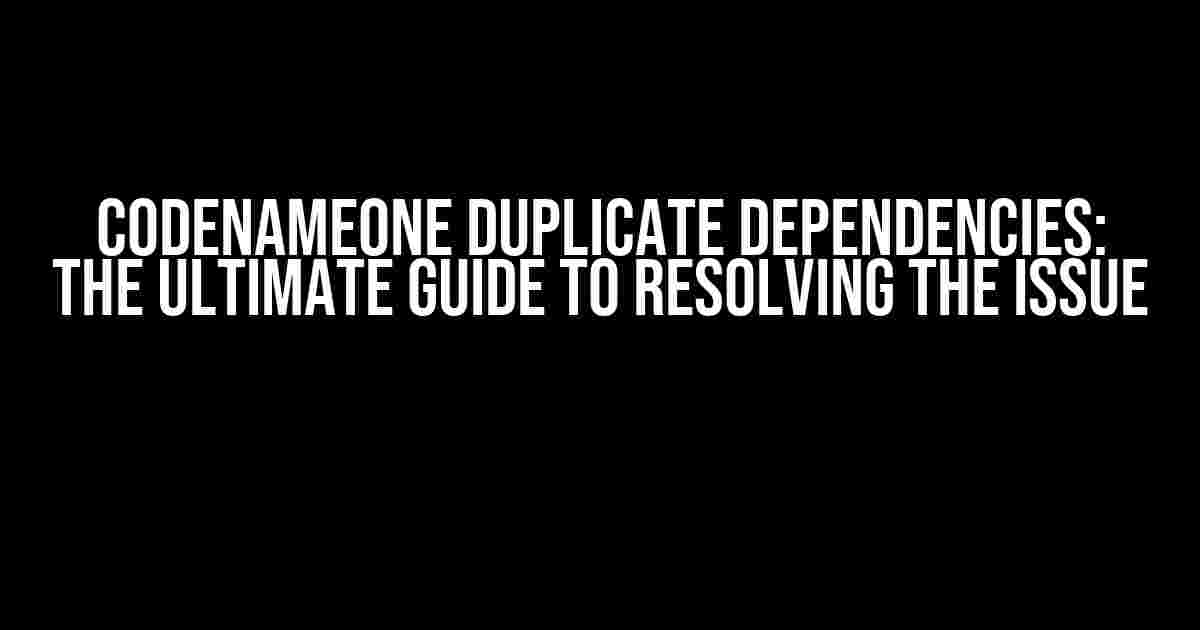If you’re a developer working with CodenameOne, you’ve probably encountered the dreaded “duplicate dependencies” error at least once. It’s frustrating, it’s confusing, and it can bring your project to a grinding halt. But fear not, dear developer! In this article, we’ll take a deep dive into the world of CodenameOne duplicate dependencies, exploring what causes them, how to identify them, and – most importantly – how to fix them.
What are Duplicate Dependencies?
In CodenameOne, dependencies refer to the libraries and frameworks that your project relies on to function properly. These dependencies can include things like third-party APIs, plugins, and even other CodenameOne projects. When you have duplicate dependencies, it means that your project is trying to use multiple versions of the same dependency, which can cause conflicts and errors.
Causes of Duplicate Dependencies
There are several reasons why duplicate dependencies might occur in your CodenameOne project. Here are some common culprits:
- Multiple imports of the same library: If you’ve imported the same library multiple times in your project, CodenameOne may try to use different versions of that library, resulting in duplicate dependencies.
- Incompatible versions of dependencies: If you’re using different versions of the same dependency in different parts of your project, CodenameOne may get confused and try to use both versions simultaneously.
- Plugin conflicts: Plugins can sometimes introduce duplicate dependencies, especially if they rely on different versions of the same library.
- inheritance from parent projects: If your project inherits dependencies from a parent project, you may end up with duplicate dependencies if the parent project has different versions of the same dependency.
Identifying Duplicate Dependencies
So, how do you know if you have duplicate dependencies in your CodenameOne project? Here are some common signs:
- Error messages: If you see error messages like “Duplicate dependency detected” or “Conflict with existing dependency,” it’s likely that you have a duplicate dependency issue.
- Build failures: If your project fails to build or compile, it could be due to duplicate dependencies.
- Unexplained behavior: If your app is behaving strangely or producing unexpected results, it could be due to conflicts caused by duplicate dependencies.
Tools for Identifying Duplicate Dependencies
Luckily, there are several tools and techniques that can help you identify duplicate dependencies in your CodenameOne project:
- CodenameOne’s Dependency Scanner: This built-in tool scans your project for duplicate dependencies and provides a report on any conflicts it finds.
- Maven’s Dependency Tree: If you’re using Maven as your build tool, you can use the `mvn dependency:tree` command to generate a dependency tree that shows all the dependencies in your project.
- Gradle’s Dependency Report: If you’re using Gradle as your build tool, you can use the `gradle dependencies` command to generate a report on all the dependencies in your project.
Resolving Duplicate Dependencies
Now that we’ve identified the culprits, it’s time to get rid of those pesky duplicate dependencies! Here are some step-by-step instructions for resolving duplicate dependencies in your CodenameOne project:
Step 1: Identify the Duplicate Dependency
Using the tools mentioned earlier, identify the specific duplicate dependency that’s causing the issue. Make a note of the dependency name, version number, and the libraries or plugins that are using it.
Step 2: Remove Unnecessary Imports
Go through your code and remove any unnecessary imports of the duplicate dependency. Make sure to remove all instances of the import statement, including any transitive dependencies.
Step 3: Update Dependencies to Compatible Versions
Update the versions of the duplicate dependency to compatible versions. For example, if you have two libraries using different versions of the same dependency, update one of them to match the other.
<dependency>
<groupId>com.example</groupId>
<artifactId>example-library</artifactId>
<version>1.2.3</version>
</dependency>
Step 4: Exclude Transitive Dependencies
If you’re using a plugin or library that’s introducing a duplicate dependency, try excluding the transitive dependency. You can do this by adding an exclusion to your `pom.xml` file:
<dependency>
<groupId>com.example</groupId>
<artifactId>example-plugin</artifactId>
<version>1.2.3</version>
<exclusions>
<exclusion>
<groupId>com.example</groupId>
<artifactId>example-library</artifactId>
</exclusion>
</exclusions>
</dependency>
Step 5: Verify and Test
After making these changes, verify that the duplicate dependency has been resolved by running your project’s build tool (e.g., `mvn clean package` or `gradle build`). Test your app to ensure that it’s working as expected.
Best Practices for Avoiding Duplicate Dependencies
To avoid duplicate dependencies in the future, follow these best practices:
- Use a dependency management tool: Tools like Maven and Gradle can help you manage your dependencies and avoid conflicts.
- Keep your dependencies up-to-date: Regularly update your dependencies to the latest versions to avoid version conflicts.
- Avoid unnecessary imports: Only import the dependencies you need, and avoid importing the same dependency multiple times.
- Use a consistent naming convention: Use a consistent naming convention for your dependencies to avoid confusion.
| Best Practice | Description |
|---|---|
| Use a dependency management tool | Tools like Maven and Gradle can help you manage your dependencies and avoid conflicts. |
| Keep your dependencies up-to-date | Regularly update your dependencies to the latest versions to avoid version conflicts. |
| Avoid unnecessary imports | Only import the dependencies you need, and avoid importing the same dependency multiple times. |
| Use a consistent naming convention | Use a consistent naming convention for your dependencies to avoid confusion. |
Conclusion
Duplicate dependencies can be a real pain in the neck, but with the right tools and techniques, you can identify and resolve them with ease. By following the steps outlined in this article and adopting best practices for dependency management, you’ll be well on your way to avoiding duplicate dependencies in your CodenameOne projects.
Remember, a clean and well-managed dependency tree is key to a successful project. Don’t let duplicate dependencies hold you back – take control of your dependencies today!
Here are 5 FAQs about “CodenameOne duplicate dependencies” in HTML format:
Frequently Asked Questions
Get the inside scoop on how to handle those pesky duplicate dependencies in CodenameOne!
What are duplicate dependencies in CodenameOne?
Duplicate dependencies in CodenameOne occur when two or more libraries or jars have the same class or resource, causing conflicts and errors during the build process. This can happen when you accidentally include multiple versions of the same library or when different libraries rely on different versions of the same dependency.
How do I identify duplicate dependencies in my CodenameOne project?
To identify duplicate dependencies, you can use the ` cn1-verbose` build hint to enable verbose mode, which will display detailed information about the build process, including duplicate dependencies. You can also use tools like the Maven Dependency Tree plugin to visualize your project’s dependency graph and spot duplicates. Additionally, you can search for errors related to duplicate classes or resources in your build logs.
What are the consequences of having duplicate dependencies in CodenameOne?
Duplicate dependencies can lead to a range of issues, including build errors, compilation errors, and runtime errors. They can also cause version conflicts, leading to unexpected behavior or crashes. In extreme cases, duplicate dependencies can even lead to security vulnerabilities, as malicious code can exploit these conflicts to gain unauthorized access to your app.
How do I resolve duplicate dependencies in my CodenameOne project?
To resolve duplicate dependencies, you can try the following steps: 1) remove unnecessary dependencies, 2) exclude duplicate dependencies from your build, 3) use dependency management tools like Maven or Gradle to manage your dependencies, 4) use the `cn1-override` build hint to override conflicting classes or resources.
Are there any best practices to avoid duplicate dependencies in CodenameOne?
Yes, there are several best practices to avoid duplicate dependencies: 1) keep your project’s dependencies up-to-date, 2) use a consistent dependency management strategy, 3) avoid including unnecessary dependencies, 4) regularly review your project’s dependencies to identify potential conflicts, 5) use tools like Dependency Finder to detect and resolve duplicate dependencies.



